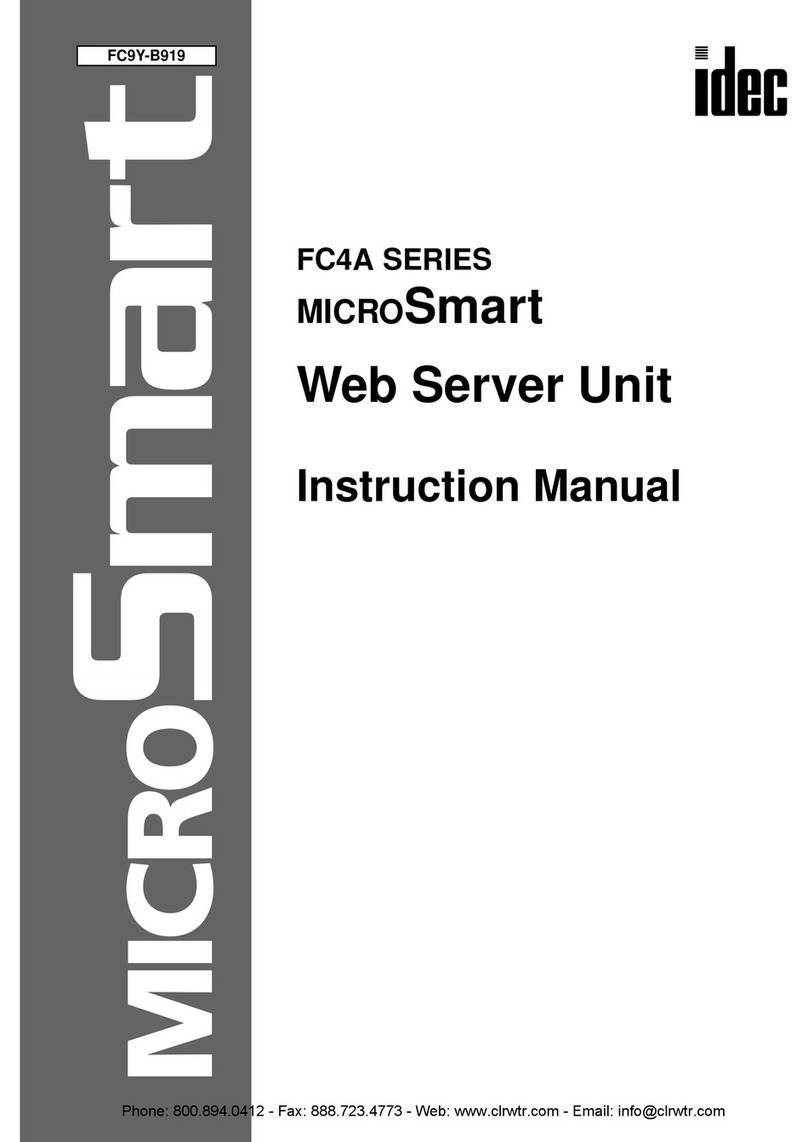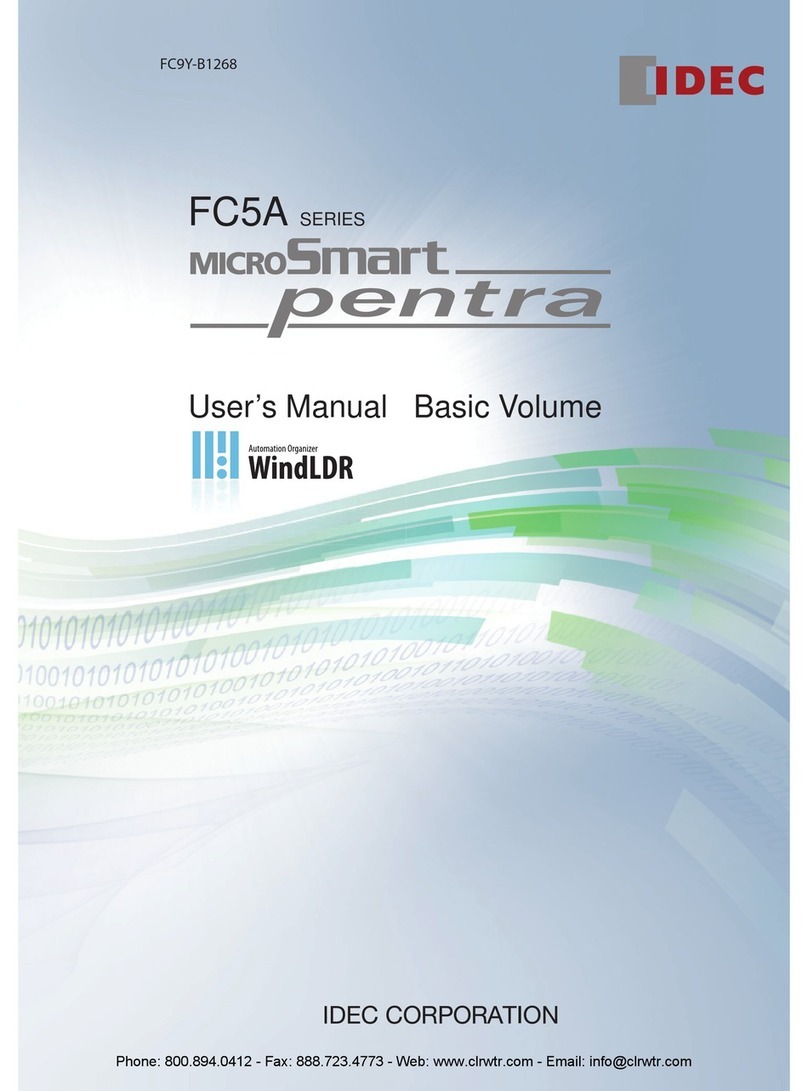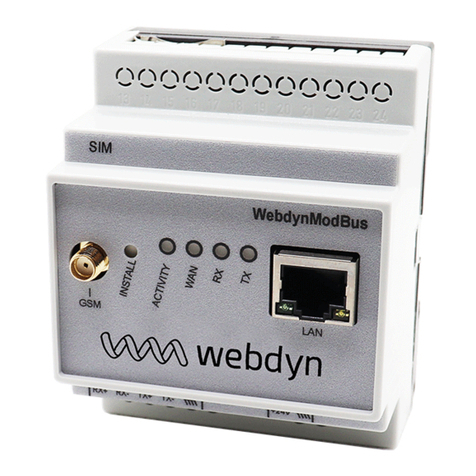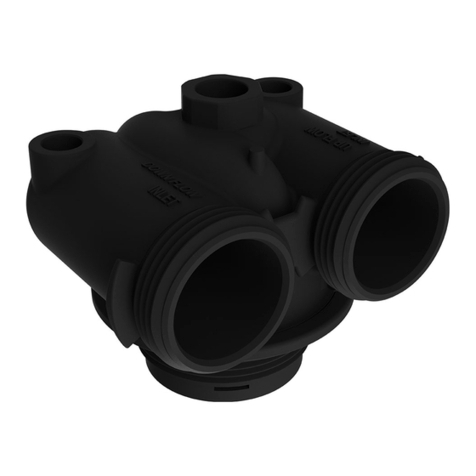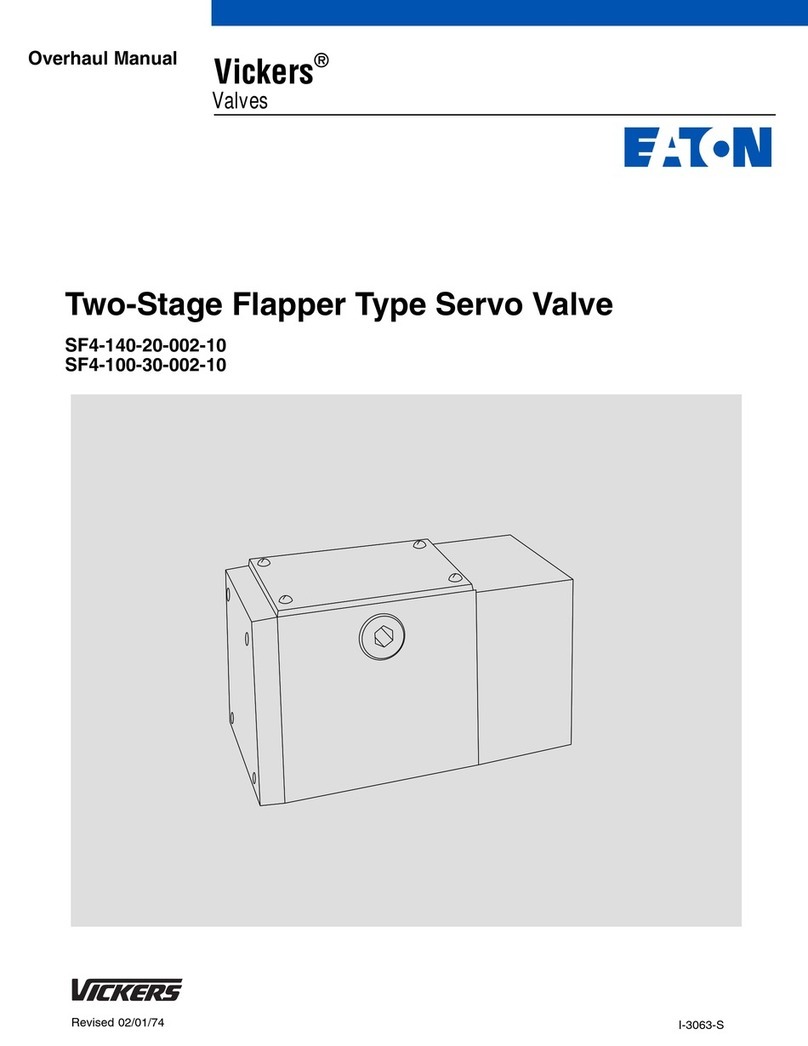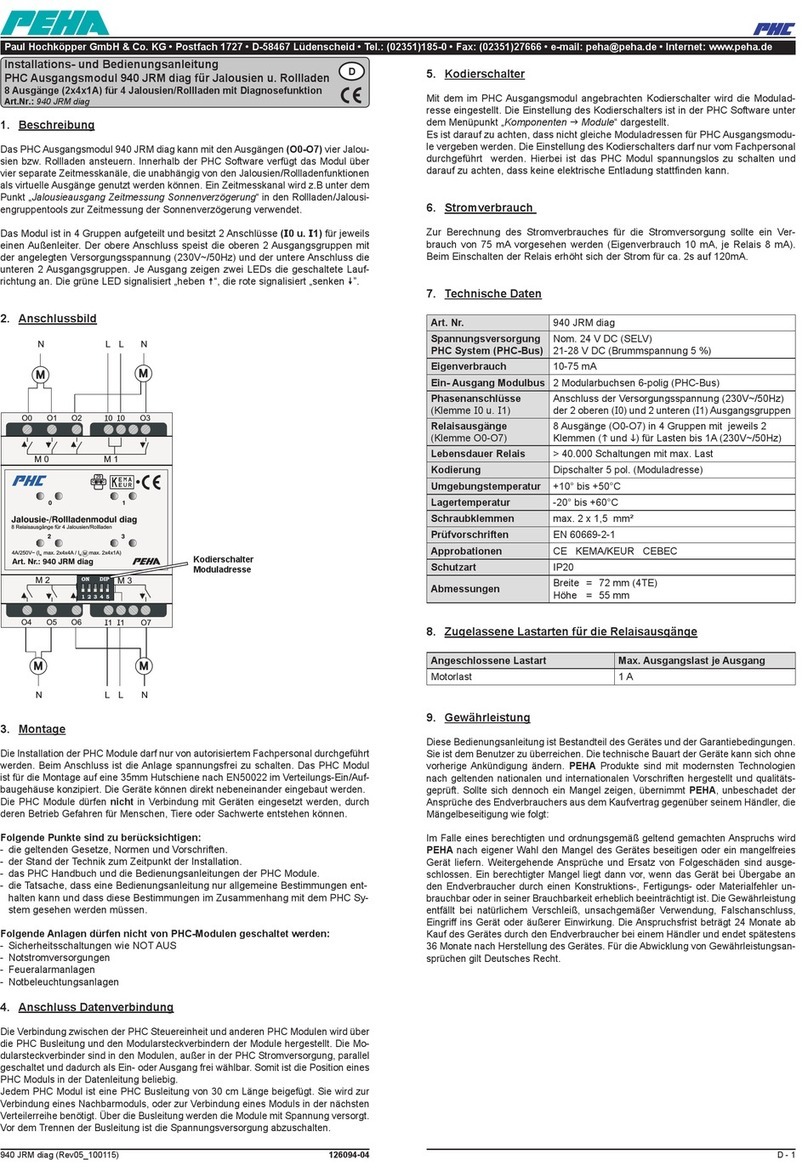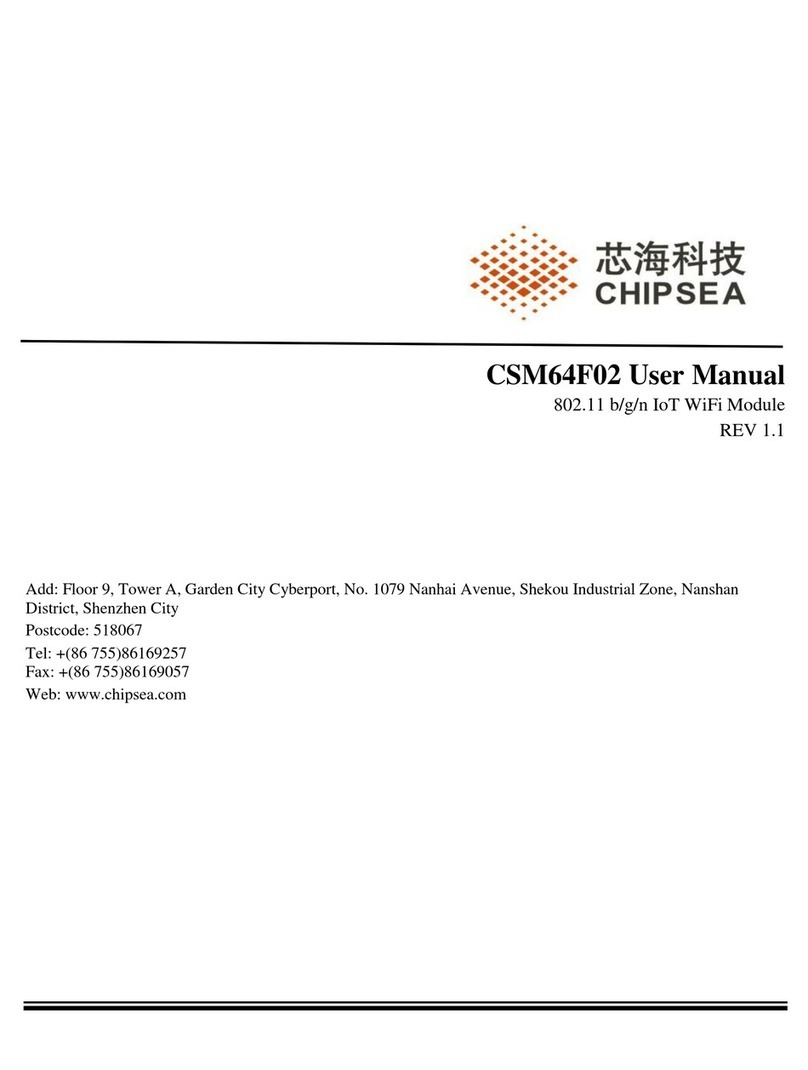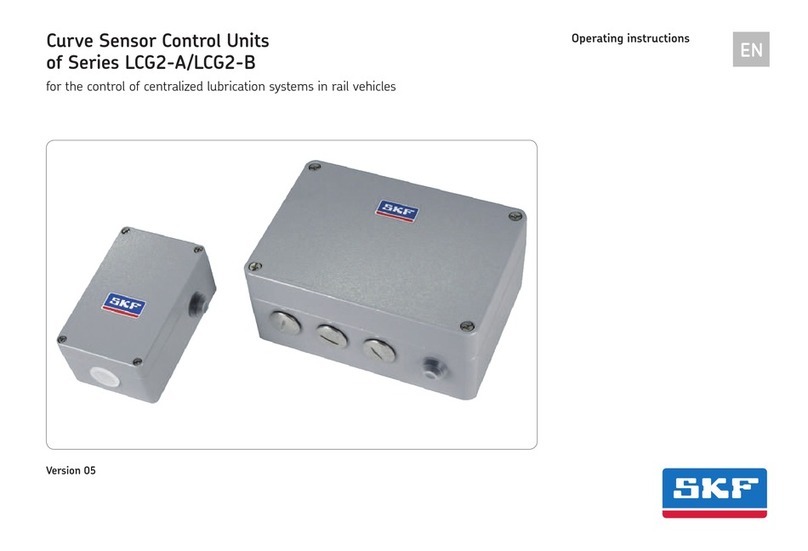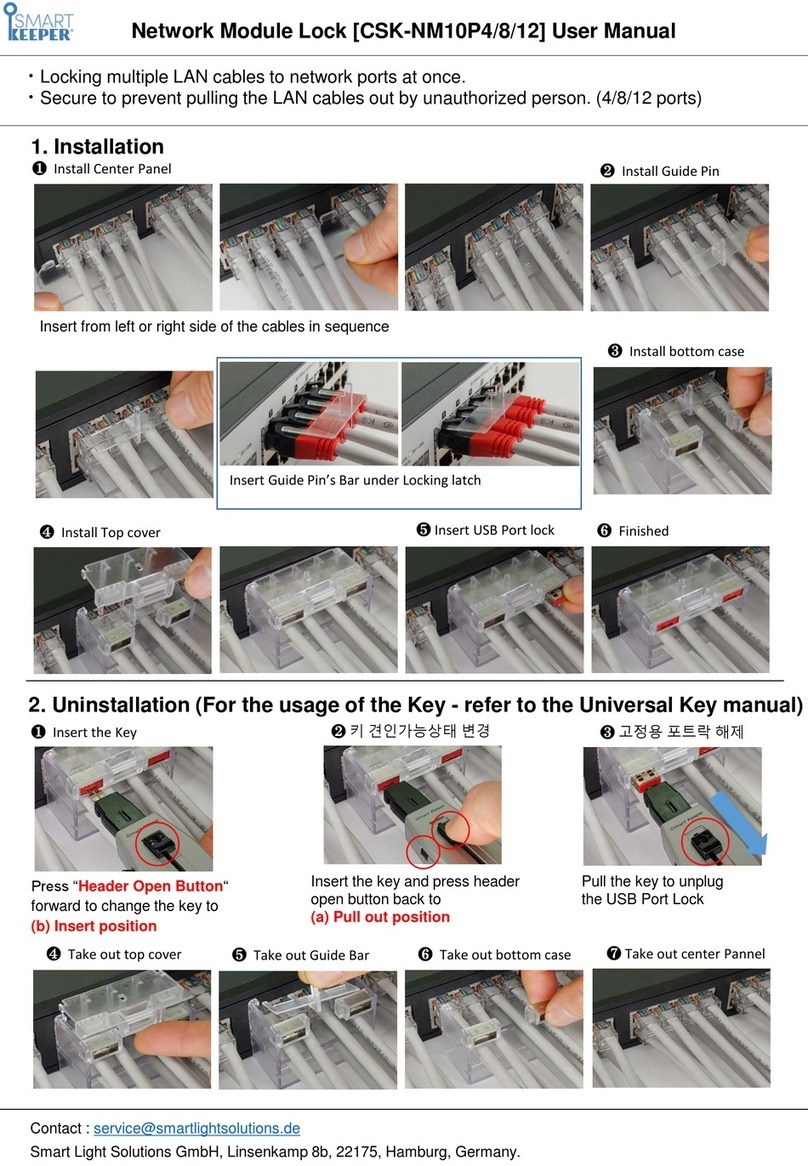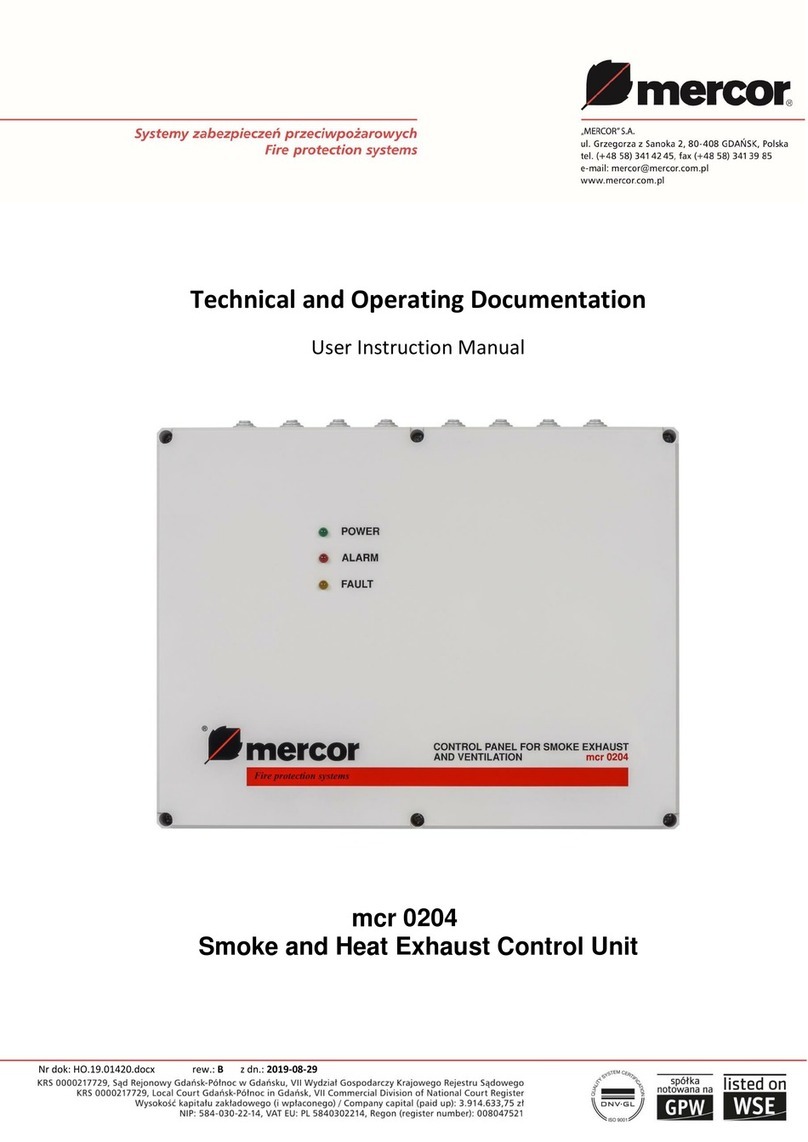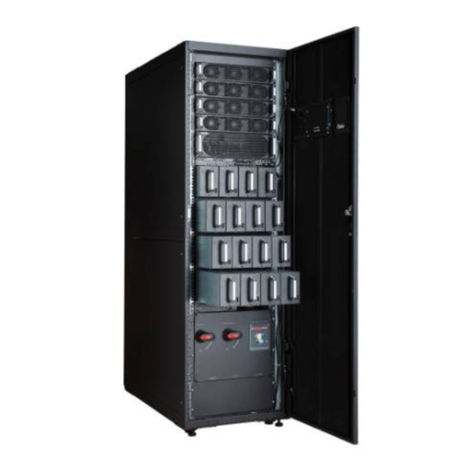IDEC LONWORKS User manual

LONWORKS® Communication Module User’s Manual i
Indicates that death or severe
bodily injury may occur, if the
corresponding safety measures
are not taken.
Safety Notices
DANGER
WARNING
CAUTION
CAUTION
WARNING
Indicates that death, severe bodily
injury or substantial material damage
will occur, if the corresponding safety
measures are not taken.
With the warning triangle, this
indicates that minor bodily
injury may occur, if the
corresponding safety measures
are not taken.
Without the warning triangle,
this indicates that material
damage may occur, if the
corresponding safety measures
are not taken.
This indicates that an undesirable
result or condition may occur, if the
corresponding instructions are not
observed.

LONWORKS® Communication Module User’s Manual ii
Copyright © IDEC IZUMI CORPORATION All rights reserved
You may not transfer or duplicate this document or utilize or reveal its contents,
unless expressly authorized in writing. In the case of a violation, you will be obliged
to pay damages. All rights reserved, in particular in the event that a patent is
granted or that a utility model is registered.
Disclaimer of liability:
We have checked that the contents of this document correctly describe the
associated hardware and software. Nonetheless, it is impossible to exclude the
possibility of deviations and therefore we cannot guarantee that there are no errors
in this document. The information in this document is checked regularly and any
necessary corrections are then made in the next release issued. We are of course
thankful for any suggestions for improvements.

LONWORKS® Communication Module User’s Manual iii
Table of Contents
1. Getting to know LONWORKS® Communication Module..... 1-1
1.1 What is LONWORKS® Communication Module ? ................... 1-1
1.2 The construction of the LONWORKS® Communication Module1-2
2. Mounting and wiring the LONWORKS® Communication Module…2-1
2.1 General guidelines .................................................................... 2-1
2.2 Wiring the LONWORKS® Communication Module .................. 2-3
2.2.1 Connecting the power supply...................................................2-4
2.2.2 Connecting the LON.................................................................2-5
3. Putting the LONWORKS® Communication Module into operation 3-1
3.1 Step-by-step.............................................................................. 3-1
3.2 The LONWORKS® Communication Module - operational status3-2
3.3 Behavior in case of a fault......................................................... 3-3
4. Supported functions.................................................................... 4-1
4.1 Virtual inputs / outputs............................................................... 4-1
4.2 Available network variables....................................................... 4-3
4.3 LON configuration parameters .................................................. 4-5
4.4 Inputs / Outputs – special considerations.................................. 4-6
4.5 Alias table entries...................................................................... 4-6
5. LONWORKS® Communication Module - Specifications ....... 5-1

LONWORKS® Communication Module User’s Manual 1-1
1. Getting to know
LONWORKS® Communication Module
1.1 What is LONWORKS® Communication
Module ?
The Local Operating Network (LONWORKS® Communication
Module) communications module is an interface for
connecting IDEC SmartRelay onto a LON network.
The IDEC SmartRelay communications module has been
implemented as a Slave module for the IDEC SmartRelay
control module.
The module supports communication between the IDEC
SmartRelay Master and external LON devices via a LON.
The LONWORKS® Communication Module is a bus station on
the LON and allows the IDEC SmartRelay to communicate
with other LON devices.
What are the capabilities of the LONWORKS®
Communication Module ?
The LONWORKS® Communication Module presents the
current states of the LON stations to the IDEC SmartRelay,
which is thus able to use its logical functions and timers to
join them together. In the process, the LON signals can also
be combined with the signals of the local IDEC SmartRelay
inputs and outputs. The LONWORKS® Communication
Module then transmits every change of the output signal via
the LON.
The combination of IDEC SmartRelay and LONWORKS®
Communication Module gives the user a decentralized
controller functionality for the LON with the capability of
setting or changing parameters or operations quickly, simply
and without a programming device.

LONWORKS® Communication Module User’s Manual 1-2
1.2 The construction of the LONWORKS®
Communication Module

LONWORKS® Communication Module User’s Manual 1-3
1. Power supply
2. Bus lock slider, interface to the IDEC SmartRelay
3. The RUN/STOP LED for IDEC SmartRelay
communication
4. The SERVICE LED
5. Input - LON connection
6. Expansion interface to the IDEC SmartRelay
7. Mechanical coding - pin
8. Service button
7
8
1
3
4
5
6
2

LONWORKS® Communication Module User’s Manual 2-1
2. Mounting and wiring the LONWORKS®
Communication Module
2.1 General guidelines
The following guidelines should be observed when mounting
wiring your LONWORKS® Communication Module:
- When wiring the LONWORKS® Communication Module,
make certain that you follow all of the applicable and
legally binding standards. Observe all of the relevant
national and regional regulations when installing and
operating the device. Check with the local authorities
regarding the standards and regulations that must be
observed in your special case.
- Make certain that the device is de-energized.
- Use only approved bus cables.
- Make certain that the specified cable lengths are used and
that the correct terminating resistors are installed properly.
- The LONWORKS® Communication Module must always
be installed as the last module on the right of the IDEC
SmartRelay, since you may not install other expansion
modules onto the LONWORKS® Communication Module.

LONWORKS® Communication Module User’s Manual 2-2
Please notice:
- The LONWORKS® Communication Module must have its
own power supply (24 V AC/DC).
NOTE
This module may only be mounted and wired by qualified
personnel, who know and observe the generally applicable
guidelines and applicable regulations and standards.
Observe the assembly and disassembly instructions in the
IDEC SmartRelay manual.
WARNING
The expansion module may only inserted or removed when
the power is off.

LONWORKS® Communication Module User’s Manual 2-3
2.2 Wiring the LONWORKS® Communication
Module
To wire the LONWORKS® Communication Module, use a
screwdriver with 3 mm wide blade.
- You do not need to use wire end ferrules when clamping
the wires.
NOTE
After the installation, the terminals must be covered. To
protect personnel against unintentional contact with the
portions of the LONWORKS® Communication Module that
are conducting electricity, the appropriate national and local
standards must be observed.
The LONWORKS® Communication Module is a double-
insulated switching device.
A protective grounding conductor is not necessary.

LONWORKS® Communication Module User’s Manual 2-4
2.2.1 Connecting the power supply
The LONWORKS® Communication Module has been
designed to serve as a Slave module for the IDEC
SmartRelay controller. It must be connected to a 24 V AC/DC
supply voltage.
Please observe the relevant instructions that are found in the
product information that was included with your equipment as
well as the technical data regarding the permissible voltage
tolerances, main frequency and current consumption.
Connecting
How to connect the LONWORKS® Communication Module to
the power:
DC supply AC supply
Protect the LONWORKS® Communication Module with a
80 mA/slow action fuse, if desired (recommended).
+
-
DC24V L
N
AC24V

LONWORKS® Communication Module User’s Manual 2-5
2.2.2 Connecting the LON
This connection is made using the two screw terminals A-B.
You can start the programming by pressing the “Service ¯”
button.
NOTE
Don't apply force when pressing the “Service ¯” button.
When contact has been made, the LED will light up in
orange.

LONWORKS® Communication Module User’s Manual 3-1
3. Putting the LONWORKS® Communication
Module into operation
A LONMARK certified application was loaded into the LON
module at the factory.
3.1 Step-by-step
1. Interrupt the voltage to the IDEC SmartRelay.
(The IDEC SmartRelay and its modules do not have
power switches.)
2. Mount the LONWORKS® Communication Module
3. Connect the power supply to the LONWORKS®
Communication Module.
4. Connect the LON bus lines to the LONWORKS®
Communication Module.
5. Remove the label with the Neuron-ID from the
LONWORKS® Communication Module and stick it on the
network plan at the LONWORKS® Communication
Module's installed location. (The Neuron-ID is also given
as a bar code on the label.)
6. Apply power to the IDEC SmartRelay and LONWORKS®
Communication Module.
7. If multiple LONWORKS® Communication Modules have
been installed, repeat Steps 1 to 6 for each LONWORKS®
Communication Module.
8. To log a LONWORKS® Communication Module in on a
LON network, you can either press the “Service” button
or enter the Neuron-ID directly in the LON using the
Installation Tool or by reading the label with a bar code
scanner.
9. The LONWORKS® Communication Module is then
registered in the LON database and ready for operation.
10. For further details regarding the LON installation, please
read the corresponding documentation.

LONWORKS® Communication Module User’s Manual 3-2
3.2 The LONWORKS® Communication Module -
operational status
The LONWORKS® Communication Module is a IDEC
SmartRelay expansion module. This module has two LED
displays:
“RUN/STOP” LED Communication with the IDEC
SmartRelay
“SERVICE” LED Service LED
LED “RUN/STOP”Lights In
Green (RUN) Red (STOP) Orange
The LONWORKS®
Communication
Module is
communicating with
the device on the left.
The LONWORKS®
Communication Module
is not communicating
with the device on the
left.
The LONWORKS®
Communication
Module 's initialization
phase
LED “SERVICE”Lights In
Green Red Orange Green /Orange
Flashing
Configure “Service”
button pressed The
LONWORKS®
Communication
Module 's
initialization
phase
Unconfigure

LONWORKS® Communication Module User’s Manual 3-3
3.3 Behavior in case of a fault
IDEC SmartRelay - Power failure
If the power to the IDEC SmartRelay fails or the
communications with the IDEC SmartRelay Master or the
communications partner to the left is interrupted, the outputs
will be set to 0. The “RUN/STOP” LED will light in RED after
one second.
IDEC SmartRelay - Power returns
The IDEC SmartRelay will startup and the LONWORKS®
Communication Module will send the parameterized status.
LONWORKS® Communication Module - Power failure
All of the inputs of the LONWORKS® Communication Module
will be set by the IDEC SmartRelay Master to 0.
LONWORKS® Communication Module - Power returns
All of the IDEC SmartRelay Master outputs will be updated.

LONWORKS® Communication Module User’s Manual 4-1
4. Supported functions
The LONWORKS® Communication Module handles the
communications between:
- The IDEC SmartRelay and LON
- Supports virtual inputs and outputs for the
communication via the LON.
4.1 Virtual inputs / outputs
The standard LONWORKS® Communication Module
application fills the complete IDEC SmartRelay process
image.
I9 I10 I11 I12
Q1 Q2 Q3 Q4 Q5 Q6 Q7 Q8 A 1 A2
Q9 ... Q16
FL1B-H12RCE FL1B-M08B2R2 FL1B-M08B2R2 FL1B-CL1C12
FL1B-H12RCE FL1B-CL1C12
A1 A2
A3 ... A8
I9 ... I24
Q5 ... Q16 LON
LON
I1 I2 I3 I4 I5 I6 I7 I8
Q1 Q2 Q3 Q4
A3 ... A8
I13 ... I24
I1 I2 I3 I4 I5 I6 I7 I8

LONWORKS® Communication Module User’s Manual 4-2
I1
I9 Q9
I14
Q16
Q6
Q1 I13
Q1 Q2 Q3 Q4 Q5 Q6 Q7 Q8
I1 I2 I3 I4 I5 I6 I7 I8 I9I10I11I12
1
2
3
I13 ... I24
Q9 ... Q16 LON
&
FL1B-M08B2R2 FL1B-CL1C12
1. To map the IDEC SmartRelay inputs (I1 to I8/I12) as
outputs on the BUS, these must be joined with free virtual
BUS outputs (Q5/Q9 to Q12) in the IDEC SmartRelay
application.
2. Operations (basic functions BF / special functions SF)
useable within the IDEC SmartRelay application
(feedback value).
3. To access the IDEC SmartRelay application (Q1 to
Q4/Q8) directly via the bus communications, these must
be joined with free virtual BUS inputs (I13 to I24) in the
IDEC SmartRelay application.

LONWORKS® Communication Module User’s Manual 4-3
4.2 Available network variables
The LONWORKS® Communication Module’s standard LON
application contains the network variables described below.
LonMark Node Object
Quantity Name Type Description
1 nviRequest0 SNVT_obj_request Request object mode
1 nvoStatus0 SNVT_obj_status Output object status
LonMark Controller Object
SNVT Description
SNVT_switch Switch light, alarm, window contact, free inputs / outputs
value=0, state=0 Þinactive
value>0, state=1 Þactive
SNVT_occupancy Occupancy:0=occupiedÞ0
1=not occupied Þ1
2=bypass Þ0
3=standby Þ1
SNVT_tod_event Scheduler program
Just current state: 0=occupied
3=standby
SNVT_temp_p Room temperature
SNVT_lux Brightness – lighting level
SNVT_lev_percent Position

LONWORKS® Communication Module User’s Manual 4-4
Assignment of the SNVT to the inputs and outputs
SNVT Name Assignment
nvoSwitchDO051 Q5
nvoSwitchDO061 Q6
nvoSwitchDO071 Q7
nvoSwitchDO081 Q8
nvoSwitchDO091 Q9
nvoSwitchDO101 Q10
nvoSwitchDO111 Q11
SNVT_switch
nvoSwitchDO121 Q12
nvoOccDO131 Q13SNVT_occupancy nvoOccDO141 Q14
nvoTodDO151 Q15
Digital
outputs
SNVT_tod_event nvoTodDO161 Q16
nviSwitchDI091 I9
nviSwitchDI101 I10
nviSwitchDI111 I11
nviSwitchDI121 I12
nviSwitchDI131 I13
nviSwitchDI141 I14
nviSwitchDI151 I15
nviSwitchDI161 I16
nviSwitchDI171 I17
nviSwitchDI181 I18
nviSwitchDI191 I19
nviSwitchDI201 I20
nviSwitchDI211 I21
SNVT_switch
nviSwitchDI221 I22
nviOccDI231 I23
Digital inputs
SNVT_occupancy nviOccDI241 I24
SNVT_temp_p nviTempAI081 AI8
SNVT_lux nviLuxAI071 AI7
nviSwitchAI011 AI1
nviSwitchAI021 AI2
nviSwitchAI031 AI3
nviSwitchAI041 AI4
nviSwitchAI051 AI5
SNVT_switch
nviSwitchAI061 AI6
nviLev_perAI011 AI1
nviLev_perAI021 AI2
nviLev_perAI031 AI3
nviLev_perAI041 AI4
nviLev_perAI051 AI5
Analog inputs
SNVT_lev_percent
nviLev_perAI061 AI6

LONWORKS® Communication Module User’s Manual 4-5
4.3 LON configuration parameters
All of the digital outputs are configured with a “Send Heartbeat”.
The LON application is configured using the Config Network
Variables. The following SCPT are available.
SCPT Description Name Assignment Default
SCPTmaxSendTime Send Heartbeat cpMaxSendTDO05 Q5 0 min
SCPTmaxSendTime Send Heartbeat cpMaxSendTDO06 Q6 0 min
SCPTmaxSendTime Send Heartbeat cpMaxSendTDO07 Q7 0 min
SCPTmaxSendTime Send Heartbeat cpMaxSendTDO08 Q8 0 min
SCPTmaxSendTime Send Heartbeat cpMaxSendTDO09 Q9 0 min
SCPTmaxSendTime Send Heartbeat cpMaxSendTDO10 Q10 0 min
SCPTmaxSendTime Send Heartbeat cpMaxSendTDO11 Q11 0 min
SCPTmaxSendTime Send Heartbeat cpMaxSendTDO12 Q12 0 min
SCPTmaxSendTime Send Heartbeat cpMaxSendTDO13 Q13 0 min
SCPTmaxSendTime Send Heartbeat cpMaxSendTDO14 Q14 0 min
SCPTmaxSendTime Send Heartbeat cpMaxSendTDO15 Q15 0 min
SCPTmaxSendTime Send Heartbeat cpMaxSendTDO16 Q16 0 min
Table of contents
Other IDEC Control Unit manuals

IDEC
IDEC HR6S Series User manual
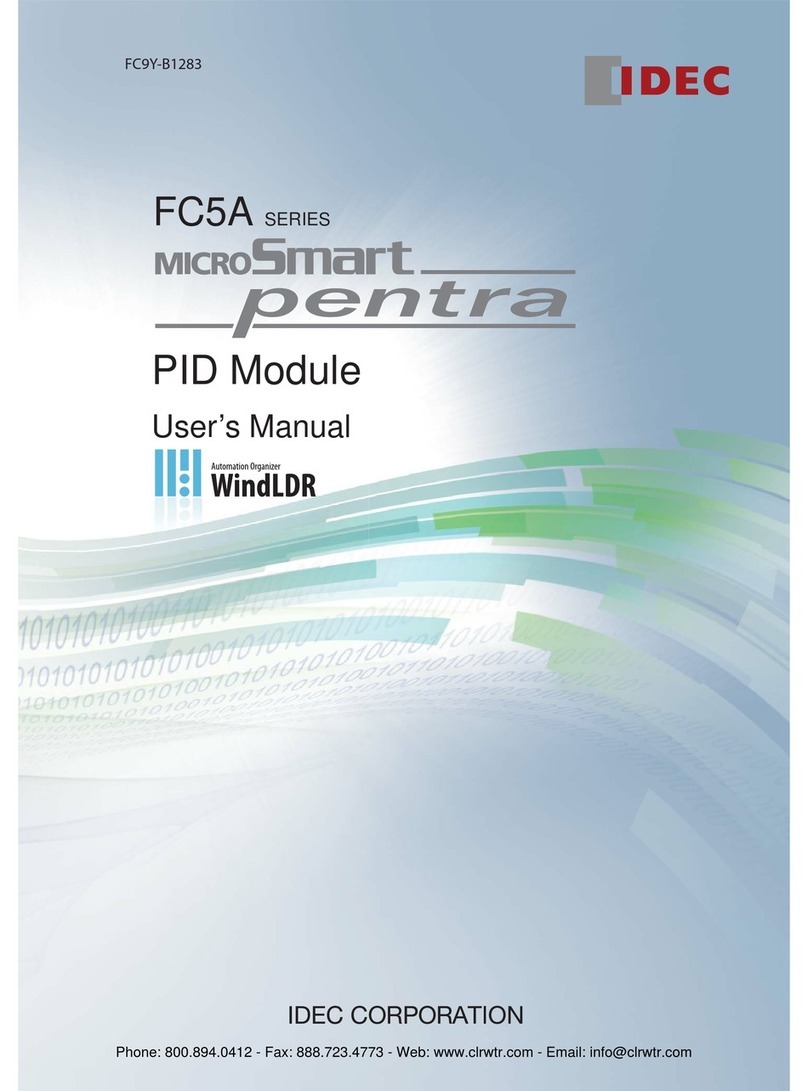
IDEC
IDEC FC5A-F2M2 User manual
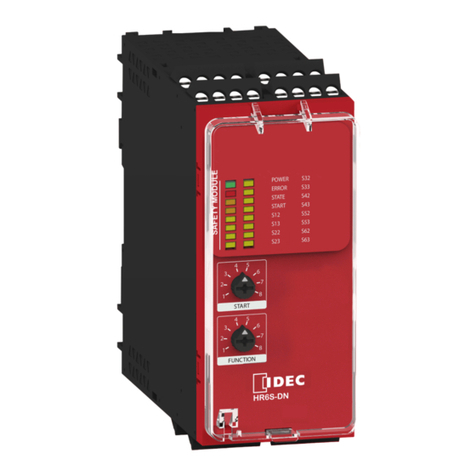
IDEC
IDEC HR6S-DN User manual
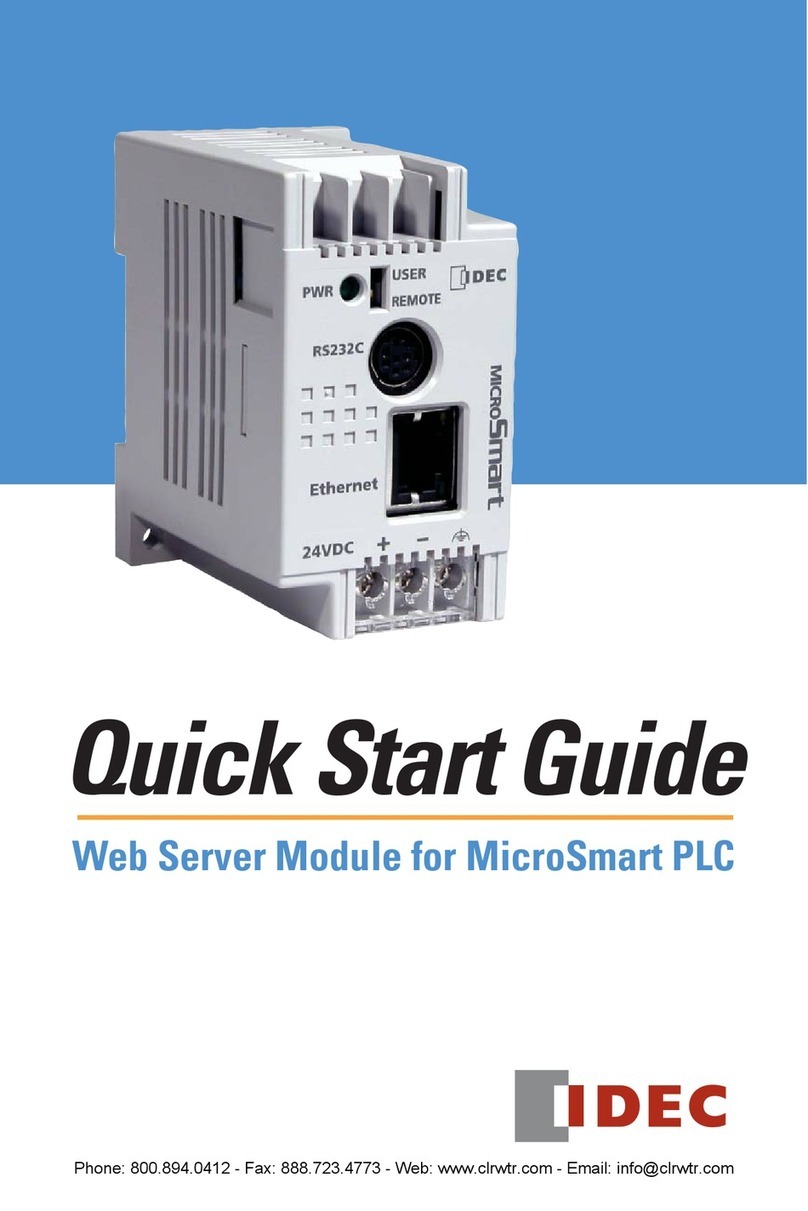
IDEC
IDEC MicroSmart Series User manual
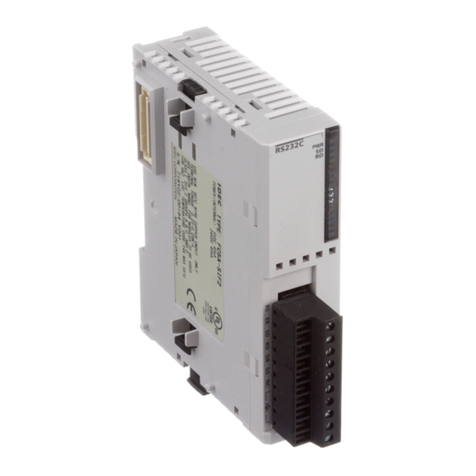
IDEC
IDEC MICROSmart FC5A Series User manual

IDEC
IDEC HR6S-S User manual
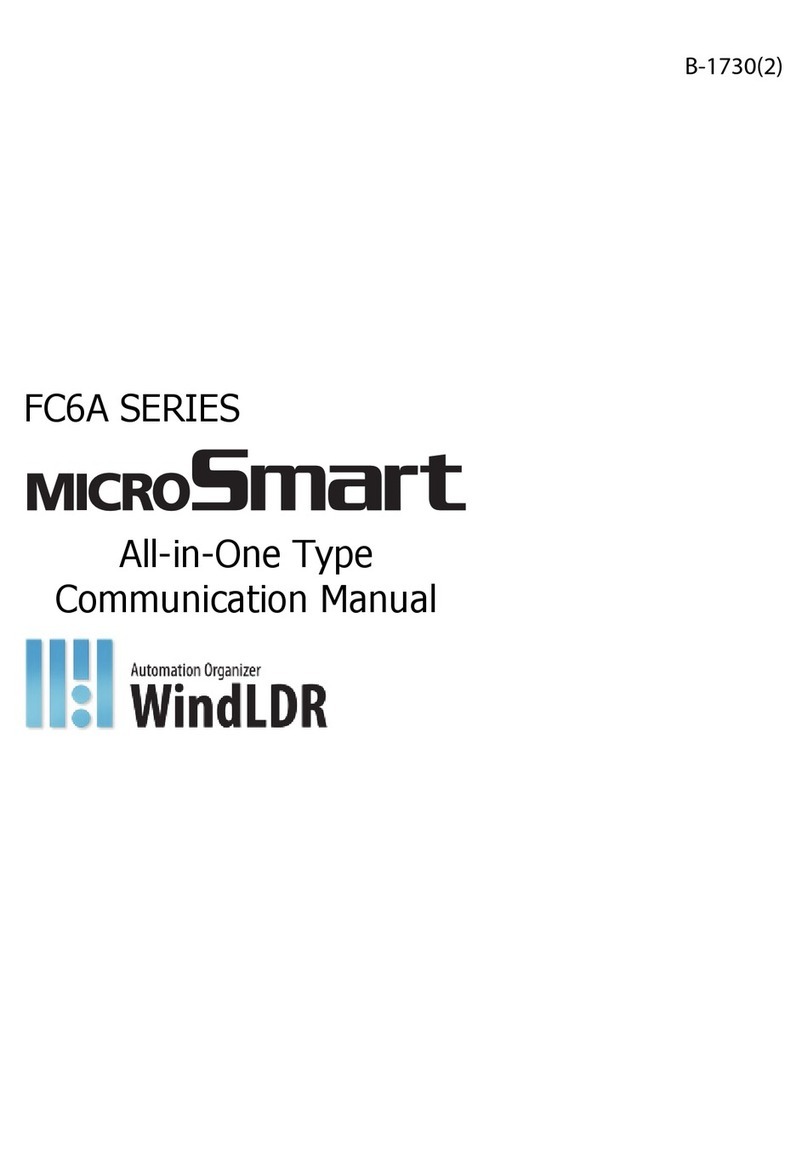
IDEC
IDEC MICROSmart FC6A-C16K1CE Use and care manual
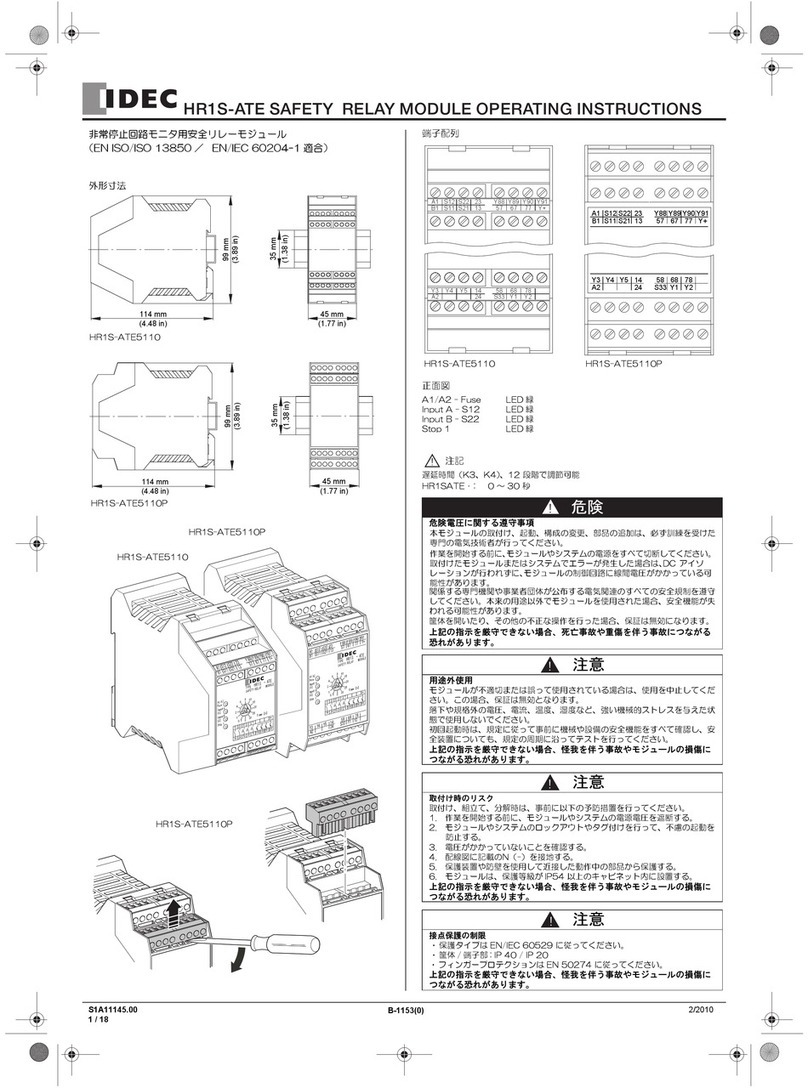
IDEC
IDEC HR1S-ATE User manual
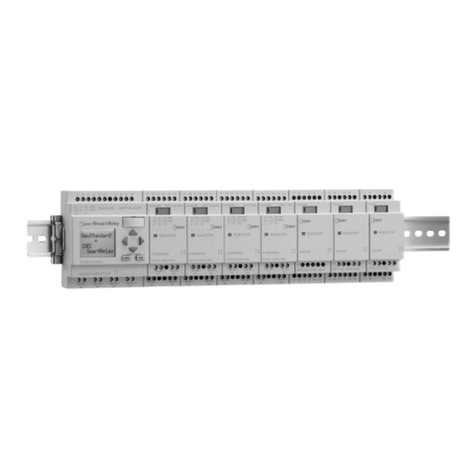
IDEC
IDEC SmartRelay FL1D Series User manual
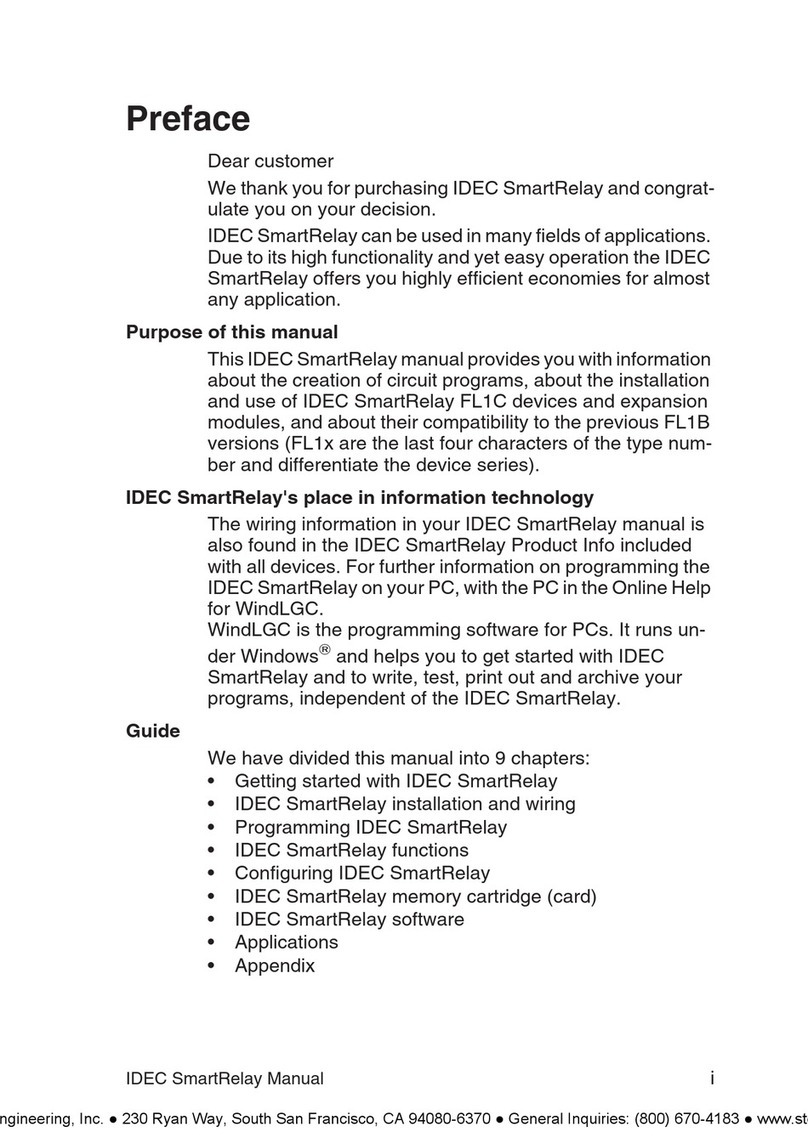
IDEC
IDEC SmartRelay Series User manual
Popular Control Unit manuals by other brands
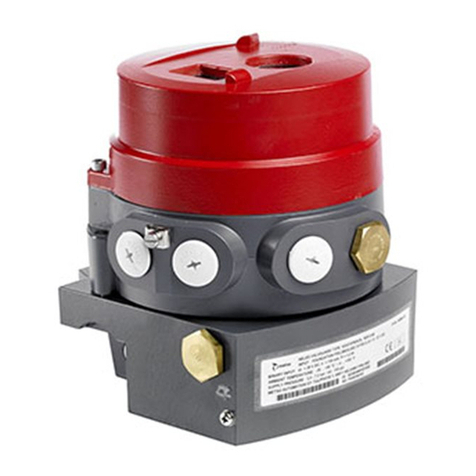
Mesto
Mesto Neles ValvGuard VG9000H operating instructions
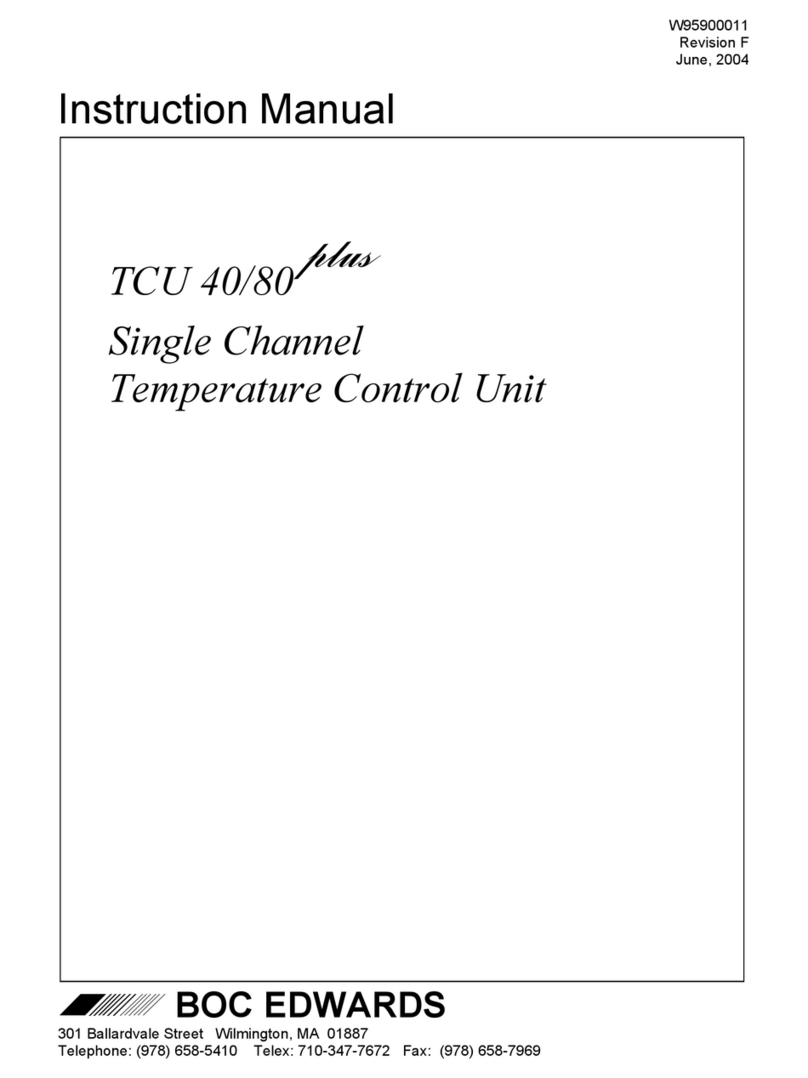
BOC Edwards
BOC Edwards TCU 40 Plus instruction manual

Neoway
Neoway N77 user guide
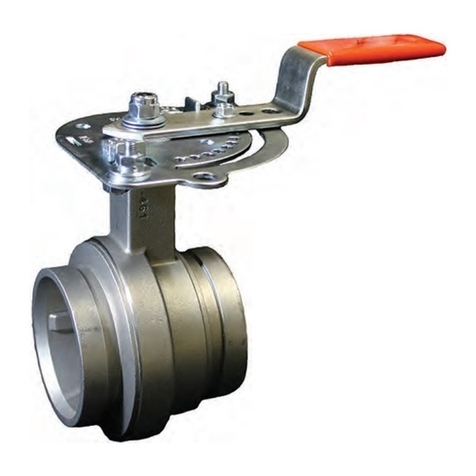
Victaulic
Victaulic Vic-300 MasterSeal 761 Series Installation and maintenance instructions

aFe Power
aFe Power 77-46101 SCORCHER HD manual
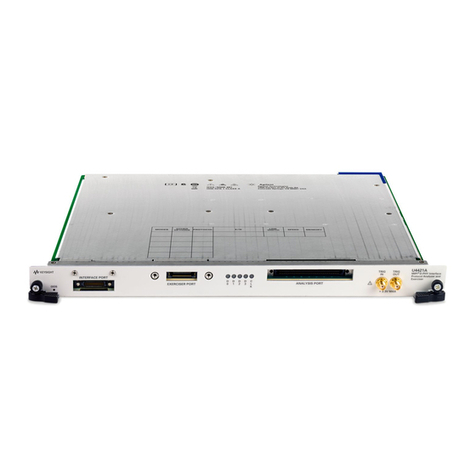
Keysight
Keysight U4421A Hardware and Probing Guide

